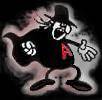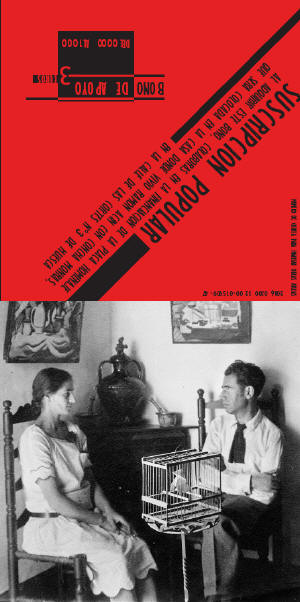
The Anarchist Encyclopedia: |

The Anarchist Encyclopedia: |

ACÍN, Ramón.
Huesca 1888 - 1936, Spanish anarcho-syndicalist, teacher, writer & avant-garde artist murdered by the fascists.
Professeur à L’Institut de Huesca
1919 : Délégué au Congrès national pour la région d’Aragon
A influencé Francisco Ponzan.
1936 : Fusillé par les fascistes à Huesca.
Biographical/historical notes:
Ramón Acin, a militant anarcho-syndicaliste, professor, writer & avant-garde artist. Involved with the C.N.T., imprisoned for his support of political prisoners, & forced into exile for his involvement in attempted uprisings.
Acin contributed many articles to the libertarian press where, in addition to art & political critiques, he expressed interest in ecology, vegetarianism, animal rights, etc.
Acin was a friend of Garcia Lorca, & also Buñuel, producing his film "Terre sans pain". He founded an art school based on the ideas of Francisco Ferrer & Célestin Freinet.
When Franco begins his fascist takeover of Spain in 1936, Ramón Acin & his partner Conchita Monrás are among the many rounded up & shot by firing squads. Authorities in Huesca refused to arm the people & the army & Guardia Civil quickly took power. The film maker Buñuel wrote that,
“When the war started, in 1936, an extreme right group turned up to arrest him at Huesca. He managed to easily escape them. The fascists then seized his wife & announced that they were going to shoot her if Acín did not present himself. The next day he did. They shot the two of them.”All his works of art at his house were destroyed by fascists too, and other sculptures were hidden by them. In 1980 a recognition of his artistic work led to exhibitions in Huesca and Barcelona.
Bakuninist Aragonese anarchist, who studied at the Instituto in Huesca where he struck up an enduring friendship with Felipe Alaiz (who would later be his biographer); in his native city in 1915-1920 he was a member of an anti-reactionary group (Bel, Alaiz, Samblancat and Maurín) and around 1920 he secured a post as a sketch artist in Huesca, the city where he spent much of his life and where he gained considerable prestige as a forward-thinking person and lover of culture.A member of the CNT, he experienced banishment, imprisonment and exile, represented the unions of Upper Aragon at numerous plenums and congresses (being on the propaganda working party at the La Comedia congress) and his disciples included Encuenta, Viñuales and Ponzán.
A friend of Galán, he did his best to prevent the uprising in Jaca, but failed and was thus indirectly obliged to flee to exile in France (December 1930-April 1931).
He occupied a position of some stature in the world of culture: his pictures were exhibited at the Dalmau gallery in Barcelona, he sculpted excellent altar pieces and sculptures and had plans for a trades museum in Aragon.
Possessing the soul of an artist, he was fond of antiquities and crafts and used a lottery win to fund Buñuel’s film Las Hurdes.
He made significant contributions to the press; he published several reviews around the region, like Mañana, Floreal, Revista de Aragón and Claridad and his flowery aphorisms in honour of his hero Salvador Seguí (1923) were famous.
Lundi, le 21.2.2000 23.30 Documentaires 27 MIN.
Film documentaire de Luis Buñuel (Espagne, 1932-30mn) Noir et blanc
Scénario : Luis Buñuel, d'après la thèse d'ethnographie de Maurice Legendre Photographie : Eli Lotar Son (1937) : Charles Goldblatt, Pierre Braunberger Musique : Symphonie n° 4 de Brahms Production : Ramon Acin ARTE / TVEUn essai de géographie humaine Présenté pour la première fois à Madrid en 1933 par Luis Buñuel, qui en lisait le commentaire au micro (la copie originale étant muette) tout en passant des disques de Brahms, cet "essai cinématographique de géographie humaine" provoqua un grand scandale. Il fut interdit jusqu'en 1937 par le gouvernement républicain, qui lui reprochait de montrer une image misérable de l'Espagne. La guerre civile ayant porté l'Espagne sur le devant de la scène, Buñuel, qui se trouvait à Paris, put enfin trouver un distributeur. Le film, sonorisé en anglais et en français, fut alors diffusé dans le monde entier avec le commentaire final du réalisateur, qui explique en détail les raisons de ce terrible état de la population, qui, selon lui, ne doit rien au hasard. Terre sans pain avait pu être tourné grâce au soutien financier d'un anarchiste espagnol, Ramón Acín, fusillé par les fascistes en 1936.
http://www.arte-tv.com/cinema/bunuel/ftext/terre.htm

Source: A Historical Encyclopaedia of Spanish Anarchism, by Miguel Iñiguez
Online, one of 400+ entries (192 pages of extracts), at Christie Books, see
http://www.christiebooks.com/html/history/archives3.html
http://libcom.org/history/acin-aquilue-ramon-1888-1936
In French, see also the C.I.R.A. page at http://cira.marseille.free.fr/bios.php?ordre=2Spanish, see "Homenaje a Ramón Acín y a Concha Monrás",
http://www.unizar.es/cce/vjuan/homenaje_acin_monras.htm
& also http://www.almendron.com/artehistoria/historia-de-espana/edad-contemporanea/ramon-acin/
page created October 2003; update December 2011
Use your back button to return to your previous page
Or visitThe Anarchist Encyclopedia | Daily Bleed Calendar | The Stan Iverson Archives | The Anarchist Timeline
anti-CopyRite 1997-3000, more or less
Questions, suggestions, additions, corrections to David Brown at dailybleed @ gmail.com
The Anarchist Encyclopedia is freely sponsored & produced by Recollection Used Books
Visitors: